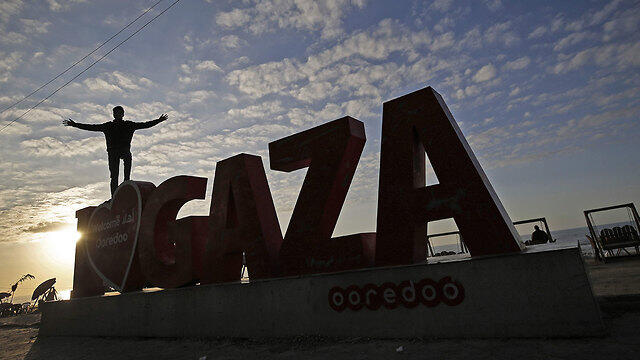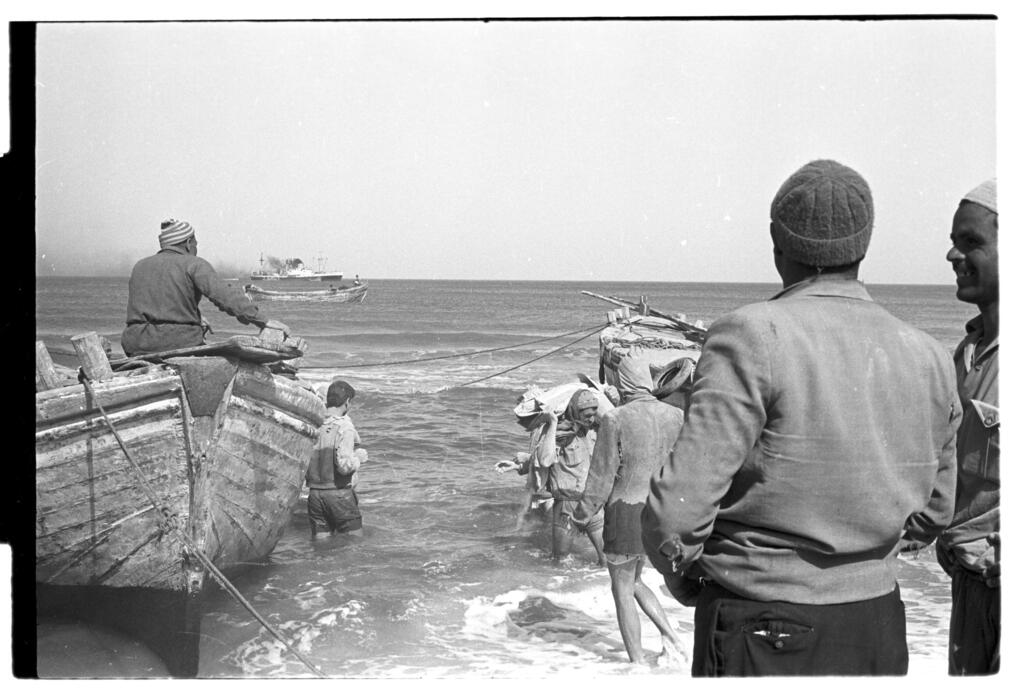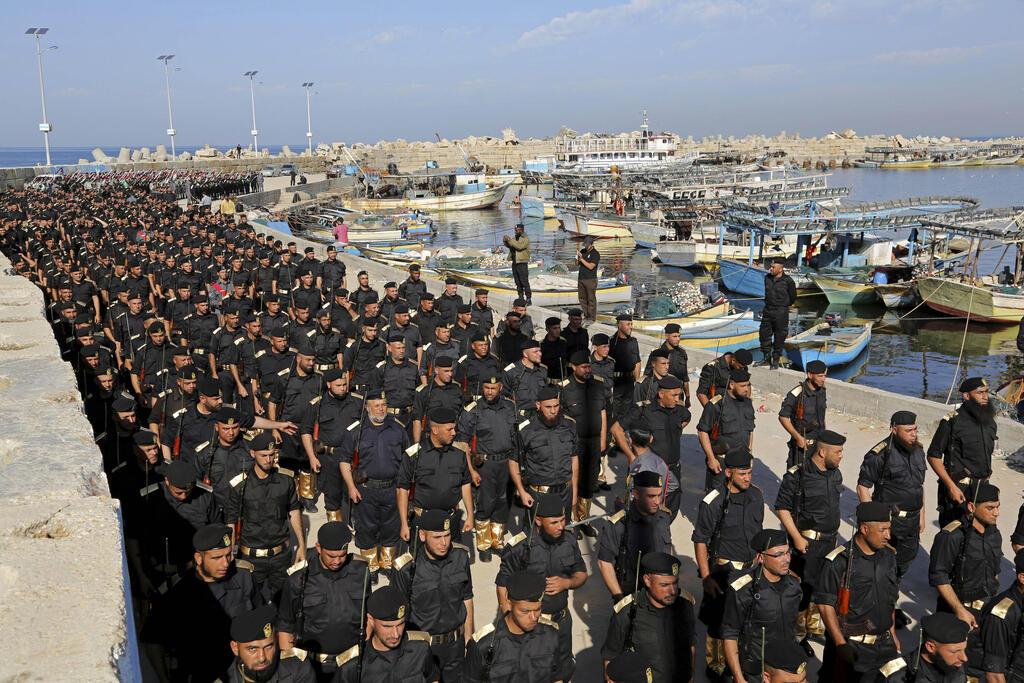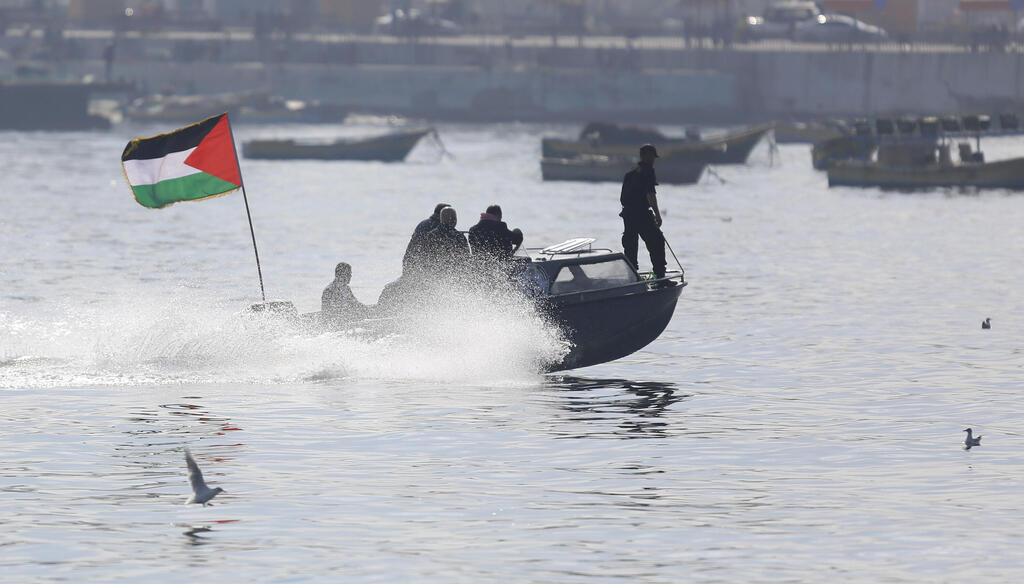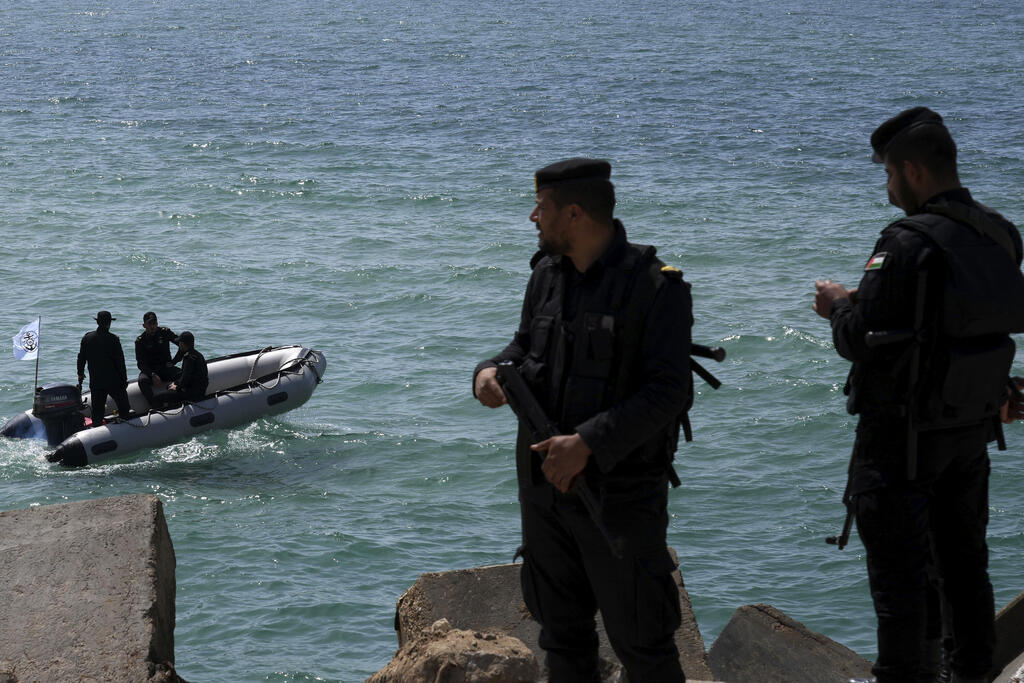Getting your Trinity Audio player ready...
The port in Gaza’s Al Rimal neighborhood wasn’t especially big. A few fishing boats would go out each day, bringing in their catch. Next to them stood Hamas’ Naval Police station where the terrorist organization’s commando unit secretly trained. On the promenade, like any city trying to promote tourism and urban pride, there’s a sign reading “I ❤️GAZA.”
Not far from there, three ancient marble pillars dating to around 335 A.D. were found, attesting to the prosperity of the port in years gone by. Nearly two thousand years on, Gaza is back to becoming a hub for the maritime transfer of goods - this time on the receiving rather than the sending end. The maritime corridor the U.S. is advancing brings the remaining residents back to the grandiose plans that have come up over the years - and have remained on paper.
This is the story of the Port of Gaza
Gaza has always been a port city or, more precisely, a city with sea access. In antiquity, under the Greeks and Romans, the part of the city by the shore was known as Maiuma or Maiumas. The port was located at an exit point from the Incense Route to the sea. The remains of Roman Maiuma were discovered in 2011 within the present area of the port – covering a half-mile along the coastline.
But as time went by, especially following the Islamic invasions and through to the modern period, Gaza moved away from the shoreline. “When we get to the 19th and 20th centuries, it’s not a city on the coast. Gaza is two miles east of the shoreline, with sand dunes between the two” says Dr. Dotan Halevy, historian of the late Ottoman Empire and the modern Middle East and Plonsky Academy fellow at the Van Leer Institute in an interview with Hakoteret podcast.
“Maritime trade was of enormous importance in the 19th century. Gaza exported a lot of grain to Europe, but not via the port” Dr. Halevy adds. “Gaza’s shore is shallow and sandy. The sand step continues deep into the sea. So, the steamships would anchor at a distance and rowboats were needed to bring goods back and forth.”
During the British Mandate, Gaza returned to the shoreline, including building the upscale Ramil neighborhood. 1946 media reports describe British intentions of building a temporary port in Gaza to reinforce the defense of the Land of Israel. “A United Press correspondent near Gaza reports that a temporary, collapsable port made of metal is to be built and that the army base near Gaza will house 50,000 men. A train will connect the port to the army base,” reported Yedioth Ahronoth.
7 View gallery
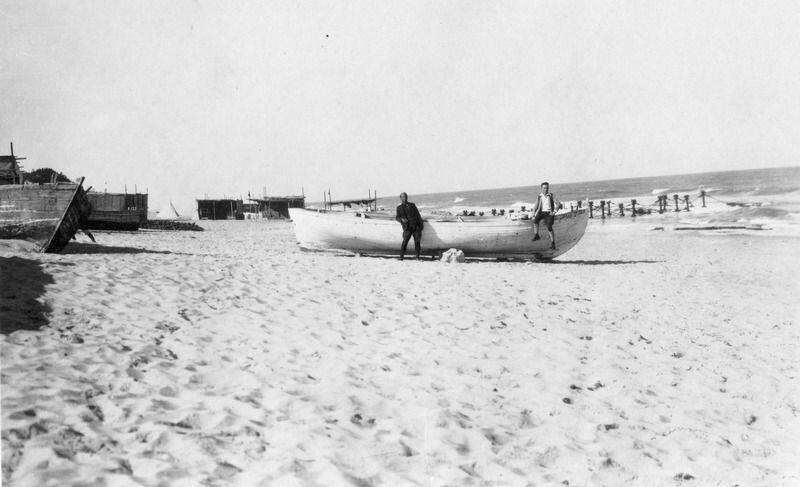

Gaza Port, 1928
(Photo: Nadav Mann, Beitmona; from the Haim Berger Collection, The Pritzker Family National Photography Collection, The National Library)
Two years following the establishment of the state, Israel tried to reach an agreement with the Kingdom of Transjordan, offering Gaza in return. The New York Times pointed out that the main difficulty in Israel-Transjordan negotiations was Abdullah’s demand for an exit to the Mediterranean, that Gaza is in Egyptian hands and that thousands of Arab refugees, whom Transjordan cannot support, live there.
Three months after Israel’s Six Day War victory, the “Directors Committee Dealing with the Administered Territories” decided to operate the Port of Gaza during the upcoming fruit export season. “We went to look for the port. We surveyed the coastal road for miles and found nothing. We asked passersby where the city port was. Many didn’t understand our question. Others pointed toward the beach, across from the main road” reported Yedioth Ahronoth a few months after the war in a special article about the port.
“We asked a few local fishermen where the port was. ‘Here’ was the answer, pointing at a half-rotten wooden bridge stretching 150 feet from the coast into the sea. As there are no communications facilities, no lighthouse and no buoys, boats only go out to a ship when they suddenly see it maneuvering in front of the city. These boats convey messages to the port about the ship and the kinds of goods it’s carrying or wants to load. Groups of dockworkers, boat owners and people of various occupations then organize immediately and start unloading the goods. If the sea’s stormy, work stops and the ship moves away into the sea.”
The man known as the Port Rais claimed the annual loading at the Port of Gaza reached about a quarter of a million tons per year. Fifty small and medium-sized ships would visit the port annually. Most import and export for Gazans was conducted via Port Said in Egypt, and then onto Gaza.
7 View gallery
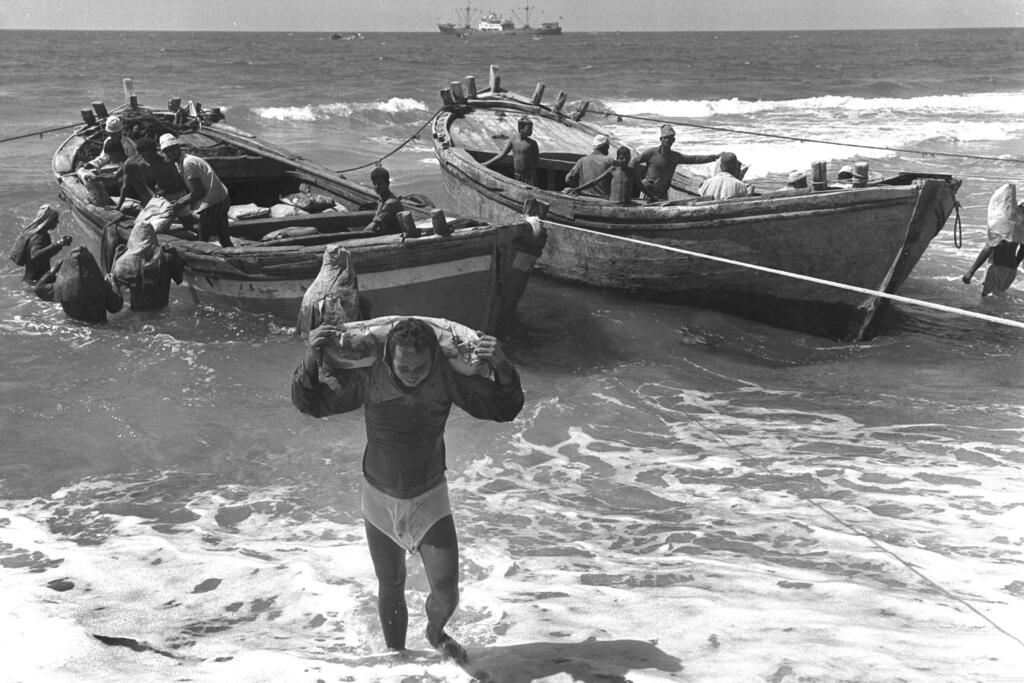

Worker carries bags of cement to the shore at Gaza Port, 1971
(Photo: GPO via gettyimages)
The reporter summed up his visit with the question “Do we really need another port in the south, when 20 miles north of Gaza we have the modern Port of Ashdod? Do we need to operate the Port of Gaza with its outdated systems?”
The reporter revisited the Port of Gaza six weeks later – during operating hours. “The deserted beach in the southern part of the city has become a bustling beehive. The red light was ignited as word spread across the city that the ship for which they had been waiting for two weeks had anchored and was ready for unloading. By 8am, 300 dockworkers were moving crates like a human ribbon onto 15 barges. They have 25,000 crates to load in three days – the time the Greek ship, Ouranoupolis, had agreed to dock in Gaza.”
Three months later, Gaza dockworkers demanded the Israeli military government prevent the export of fruit via the Port of Ashdod. When the military government refrained from getting involved in the dispute, the workers considered striking or demanding higher wages.
In the early 1970s, ships carrying cement also reached the Port of Gaza. “Israel tried to provide some sort of livelihood and turn Gaza into a cement terminal for Israel. To this end, Israel built two wharves south of Gaza City,” says Dr. Halevy.
A 1972 article describes the port as a place filled with work. “The Port of Gaza, which used to be closed for most months of the year and only opened during the citrus season, is now bustling with activity. Ships come in and out and part of the cement import into Israel comes through the Port of Gaza. A new wharf and breakwater have been built at the port and another wharf will be built soon.”
Cement cargo continued arriving at Gaza through the Yom Kippur War, but the project didn’t last too long. “There’s even a visual reminder. One of these cement ships sank and has been left as a monument of sorts in front of Gaza’s beaches, stranded between air and water” Dr. Halevy says.
Winds of peace and port attack
The initiative of building a deep port in Gaza to accommodate large ships was revived during Israeli-Palestinian talks in the early 1990s. A 1991 study, first published in Yedioth Ahronoth, determined that such a move would be viable.
"An investment of approximately half a billion dollars to build the Port of Gaza, including a system of wide and fast access roads, with an annual cargo capacity of about 7 million tons of cargo, would yield a direct economic profit of about $250 million over thirty years," claimed the article about the study.
After the Oslo Accords were signed, a plan to build a proper port started taking shape. Gazan engineers presented the PLO with development plans for the port. Israel’s Ministry of Transport prepared a contingency plan for collaboration between the Port of Gaza and the Port of Ashdod and international entrepreneurs looked into the feasibility of investing in the project.
In September 1993, the port wasn’t in such great shape. “Right now, the port is small and outdated and is mainly used as a fishing port. The port is also used for unloading food products imported into the Strip by the UN’s refugee relief agency. To render the port suitable for unloading cargo in significant quantities, a breakwater must be built, dredging works need to be carried out and wharves for docking ships have to be built."
Upon his return to Gaza, Yassir Arafat began advancing the construction of proper air and sea ports in Gaza – mainly because he was fed up with the coordination required with Israel for his own overseas travel. In the initial stage, the Palestinians started renovating the wharf Israel had built. External funding for building a proper port arrived in September 1994. France, Italy and the Netherlands signed an aid agreement, investing $60 million, in building the port.
However, Israel delayed granting permits to begin infrastructure works. The Wye Agreements, signed by Prime Minister Benjamin Netanyahu and PLO Chairman Yassir Arafat, clearly address the port, plainly outlying Israeli and Palestinian commitment to “proceeding without delay to conclude an agreement to allow the construction and operation of the port in accordance with the prior agreements. The Israeli-Palestinian Committee will reactivate its work immediately with a goal of concluding the protocol within sixty days, which will allow the commencement of the construction of the port.”
Almost a year later, then prime minister, Ehud Bark signed the Sharm El Sheikh Memorandum, committing to infrastructure works for the port commencing within the month. The works were delayed, but did kick off and were then halted. Then, in January 2002, the Shayetet 13 reconnaissance unit blew up the Port of Gaza.
This occurred a mere 10 days following the navy seizing the Karin A ship, loaded with Iranian weapons, en route to the Port of Gaza. During the raid, a ship owned by Yasser Arafat and used for gathering intelligence against Israeli targets was also destroyed.
Blockade, plans, flotilla
Following Israel's 2005 pullout from Gaza, it allowed the Palestinians to operate the small port in Gaza. Works for building a larger port were due to commence soon and the Palestinian Authority (PA) planned to build warehouses for the port on the evacuated land of Netzarim.
But then Hamas took power, Israel declared the Gaza Strip an enemy entity and imposed a full blockade on the Gaza Strip. Ships and cargo could no longer enter Gaza by sea. The port, which at the time was operating more as a fishing than cargo port, was left with fishermen and a naval police station built by the PA.
One of the better-known attempts to break the naval blockade was that of the Turkish MV Mavi Marmara in 2010. Six ships with pro-Palestinian activists and humanitarian aid sailed from Turkey toward the Port of Gaza. Israel offered the activists the opportunity to unload the cargo at the Port of Ashdod that, following security checks, would be transferred to Gaza by UN and Red Cross personnel. Flotilla participants rejected the offer and continued sailing toward the Port of Gaza. Shayetet 13 combatants took over the ships. The flotilla passengers attacked the soldiers and nine Shayetet 13 soldiers were killed in the clashes.
In 2014, Palestinian Transport Minister Nabil Dmaidi revealed that Egypt and the PA were working on a plan to build a seaport in the Gaza Strip as well as two airports in Judea and Samaria. Four years later, a plan to build a port in Gaza came up again – this time from a surprising place – then security minister, Avigdor Liberman. The plan, previously proposed by the navy, included permission to operate a port in Gaza on condition the ships and cargo were checked by Israel at a foreign port, possibly in Cyprus.
We can’t talk about plans for building a port without talking about current transport minister, Israel Katz’s plan for an island. This plan proposes an artificial island be built in front of the Gazan coast, connected to Gaza by a series of bridges. There is to be an international airport on the island as well as a port to receive goods by sea. The island will be under international control and supervision and have security points and desalination and energy-creating facilities for Gazans.
Tourist attraction or Hamas base?
Anyone visiting the Port of Gaza in recent years might for a moment feel they’re in a run-of-the-mill small Mediterranean town. Upscale restaurants and little stalls scatter the promenade. There’s a big “I ❤️GAZA” sign serving as a meeting point for home tourism, a monument for the Marmara flotilla and little fishing boats with their daily catch.
But beneath the surface, Hamas has exploited the spot to advance its murderous plans. Alongside the little fishing boats, the port served as a base for Hamas’s naval commando - those same terrorists who carried out the massacre on Zikim beach, and tried to get to Ashkelon and further spots along Israel’s coastline.
The IDF has raided the Port of Gaza during the course of the war, destroying the monument memorializing the Marmara incident. Findings within the port territory include RPG launching pads and further evidence of Hamas’s commando unit’s activity at the site.
Seaborne goods return to Gaza
After almost two decades of no goods entering Gaza by sea, the war has changed the situation. U.S. President Joe Biden has instructed the army to build a floating dock adjacent to the Gazan coast to bring in humanitarian aid for Gazans.
The new facility will consist of two parts: a floating dock from which packages will be transferred to the coast; and a maritime platform from which aid can be transferred from large to small ships that can approach the floating dock. "Once we get fully mission-capable, we will be able to push up to two million meals, or two million bottles of water, ashore each day," said U.S. Army Brigadier General Brad Hinson.
According to the plan, humanitarian aid arriving from the UAE will undergo security checks in Cyprus, and only then will the ships continue to the floating dock the Americans are going to build. It was announced this week that, contrary to Israeli wishes, Qatar is also to be involved in building and operations of aid coming in by sea.
Last weekend saw the first signs of aid arriving by sea. In a pilot operation, akin to the plan for the floating dock the Americans are building, a Spanish ship that underwent security inspection in Cyprus got close to the Gazan coast and transferred the aid by sea.



